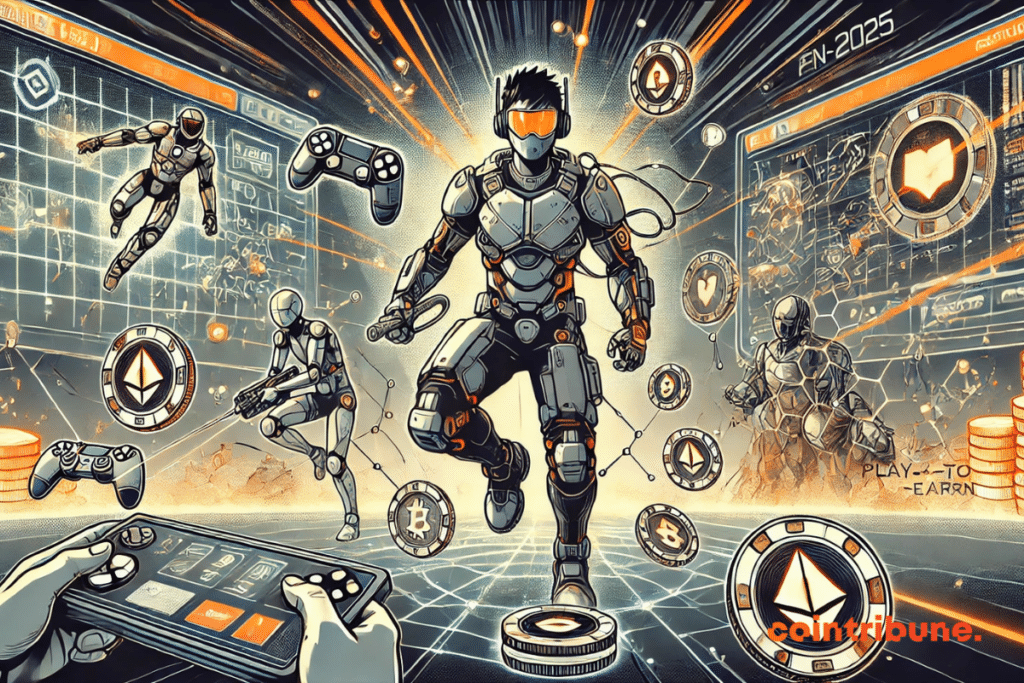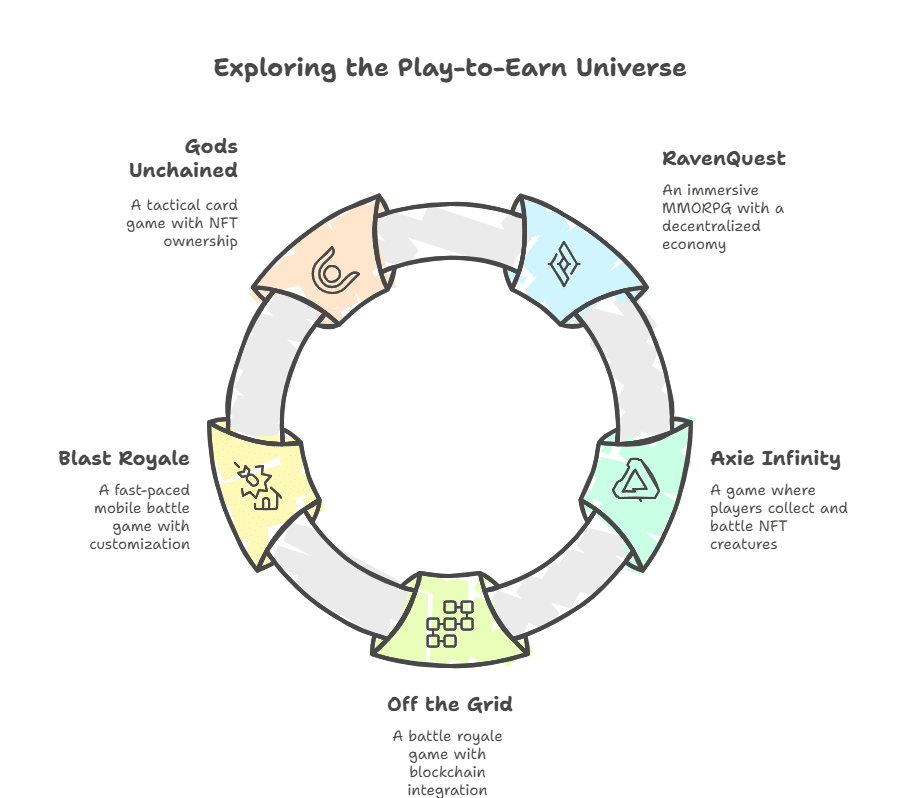The Best Play-to-Earn Games in 2025
The Play-to-Earn (P2E) allows players to earn tokens or NFTs, which can be exchanged on specialized marketplaces. This model is based on blockchain technology, ensuring transparency of transactions and actual ownership of digital assets. Unlike traditional games, it offers an open economy where players can sell or use their earnings freely. With the rise of cryptocurrencies, P2E is transforming the gaming industry by integrating a financial dimension. This article presents the best Play-to-Earn games in 2025. It explores the blockchains and platforms supporting them and analyzes the challenges, opportunities, and perspectives of Web3 gaming.

In brief
- Definition: Play-to-Earn (P2E) is a blockchain-based gaming model where players earn cryptocurrencies or NFTs exchangeable for real value.
- Ecosystem: Supported by blockchains like Ethereum, Polygon, and Immutable X, this model offers transparency, security, and digital ownership.
- Importance: Generates income, creates decentralized economies, and transforms player communities into economic actors.
- Challenges: Unclear regulations, token volatility, technical complexity for new users.
- Perspectives: Improvements in infrastructure, diversification of games, and appropriate regulation could make it a sustainable pillar of Web3 gaming.
The most popular Play-to-Earn games in 2025
In 2025, the Play-to-Earn (P2E) model continues to revolutionize the video game industry. Several titles stand out for their popularity and innovation. Here is a detailed presentation of these flagship games.

RavenQuest
RavenQuest is a MMORPG that offers an immersive experience with a decentralized economy. Players can own land, participate in quests, and trade resources, all supported by blockchain technology. This game stands out for its rich open world and in-depth gameplay mechanics, allowing players to truly immerse themselves in the world of RavenQuest.
Axie Infinity
Axie Infinity continues to be a pillar of P2E in 2025. Players collect, breed, and battle creatures called Axies, each Axie being a unique NFT. The game has a robust economy where players can earn tokens by participating in various activities. Its continued success is a testament to the strength of its economic model and the commitment of its community.
Off the Grid
Off the Grid is a battle royale shooting game that made a splash in 2024 and continues to attract players in 2025. The game plans to launch the GUN token, which will allow players to purchase new maps, weapons, and customizations. Some competitions will also require the use of this token. This integration of blockchain enriches the gaming experience by offering economic opportunities to players.
Blast Royale
Blast Royale is a fast-paced online battle game where players compete to be the last survivor. With vibrant graphics and short matches, it is ideal for mobile gaming. Players can customize their characters with various weapons and equipment, adding strategic depth to each battle. This game skillfully combines accessibility and complexity, attracting a wide audience of players.
Gods Unchained
Gods Unchained is a tactical collectible card game that combines the strategic depth of a card game with the power of blockchain technology. Players build and customize decks from over 1,800 cards with unique abilities, allowing them to fully own, trade, collect, and sell their cards as valuable NFTs. This true ownership of digital assets offers a new dimension to the card game genre.
These games illustrate the diversity and innovation present in the Play-to-Earn field in 2025, offering players enriching experiences and unprecedented economic opportunities.
The platforms and blockchains supporting Play-to-Earn
The Play-to-Earn (P2E) model relies on robust technological infrastructures that ensure security, transparency, and efficiency of transactions. Among these infrastructures, some blockchains and platforms stand out for their adoption and performance.

Ethereum
Ethereum is one of the most used blockchains for P2E game development. It offers smart contracts and token standards like ERC-721 for NFTs. Games such as Axie Infinity and Ember Sword operate on Ethereum, taking advantage of its security and wide adoption.
However, Ethereum faces challenges, including high transaction fees and limited scalability, which can affect user experience in P2E games. To address these limitations, scaling solutions have been developed.
Polygon
Polygon is a scaling solution for Ethereum that offers fast and low-cost transactions. It attracts many P2E game developers by enhancing the user experience. For example, games like Ember Sword initially planned to use Polygon to improve user experience.
Polygon uses sidechains and other technologies to offload the main Ethereum network, thereby reducing gas fees and increasing transaction speed. This approach allows P2E games to run more smoothly, providing players with a more enjoyable experience.
Immutable X
Immutable X is a Layer 2 scaling solution for Ethereum, specially designed for NFTs. It offers instant transactions without gas fees, which is essential for high-transaction-volume P2E games. Games like Ember Sword have migrated to Immutable X to benefit from these advantages.
By using a technology called zk-rollups, Immutable X bundles many transactions into one, thereby reducing the load on the main Ethereum blockchain. This allows P2E games to handle a large number of transactions without compromising security or efficiency.
These platforms and blockchains play a vital role in supporting and developing Play-to-Earn games, providing solutions to technical challenges and enhancing the player experience.
The challenges and opportunities of Play-to-Earn in 2025
The Play-to-Earn (P2E) model continues to transform the video game industry in 2025, offering significant opportunities while posing notable challenges.
Opportunities
The P2E offers players around the world the ability to generate income, regardless of their geographical location. This accessibility allows populations often excluded from traditional financial systems to participate in a thriving digital economy.
For example, games like CryptoGem and Catoff allow players to earn crypto by engaging in fun activities, thus opening up new economic prospects.
The decentralized economy
P2E games promote the creation of autonomous virtual economies, where players fully control their digital assets. Thanks to blockchain technology, every item or character acquired in the game can be traded, sold, or improved transparently.
This decentralization reduces dependence on centralized entities and offers greater economic freedom to players. For example, games like Gods Unchained allow players to truly own their cards, which they can trade or sell on NFT marketplaces.
New economic models
The P2E introduces innovative economic models where players’ time and skills are financially rewarded. This approach redefines the relationship between developers and players, transforming player communities into active economic actors. Games like Illuvium and Star Atlas offer mechanisms where players can earn tokens by exploring virtual worlds or completing specific missions.
Challenges
Regulatory uncertainty surrounding cryptos and NFTs can hinder the adoption of P2E. Governments and financial authorities struggle to keep pace with the rapid technological innovation, resulting in legal gray areas. This situation can deter potential investors and players, fearing legal or tax repercussions. For example, some countries have already imposed restrictions on the use of cryptos, directly impacting P2E games.
Economic sustainability
Ensuring the stability of virtual economies in P2E games is a major challenge, particularly because of the volatility of tokens. Rapid fluctuations in crypto values can affect profitability for players and the economic viability of the games themselves.
For example, a sudden drop in the value of a token used in a game can discourage players and lead to a decrease in activity on the platform. Games like Axie Infinity have already faced such challenges, requiring economic adjustments to maintain player engagement.
User experience
Simplifying access and usage of P2E games is essential to attract a broader audience, particularly those who are not familiar with blockchain. The complex processes related to creating digital wallets, purchasing cryptos, or interacting with smart contracts can be obstacles for newcomers.
Improving the user interface and providing tailored tutorials are necessary measures to democratize access to P2E. Platforms like Polygon are working to reduce these barriers by offering scaling solutions for Ethereum, making transactions faster and cheaper.

Future perspectives for Play-to-Earn
Play-to-Earn is rapidly evolving and transforming the video game sector. New technologies are enhancing its adoption and opening economic opportunities for players and developers.
The improvement of blockchains reduces transaction fees and speeds up in-game interactions. Solutions like Layer 2 and sidechains facilitate the integration of Play-to-Earn into mainstream titles. Studios are exploring hybrid models that combine Free-to-Play and Play-to-Earn to reach a wider audience.
Large companies are investing in this model to attract new users. The rise of interconnected metaverses encourages a smoother use of digital assets.
Regulatory challenges remain, but clearer legal frameworks could encourage adoption. Play-to-Earn could establish itself as a pillar of modern gaming by offering immersive experiences and a decentralized economy accessible to all.
Play-to-Earn has profoundly transformed the industry of Web3 gaming by providing players true digital ownership and new economic opportunities. Technological advancements and the growing adoption of blockchain strengthen this model, despite challenges related to regulation, token volatility, and user experience. The future of P2E will depend on its ability to democratize, offer quality games, and ensure stable virtual economies. If these conditions are met, it could become an essential pillar of modern gaming, blending entertainment and monetization.
FAQ
No, some P2E games allow players to start for free but offer advantages to those who purchase NFTs or tokens. Others require the upfront purchase of digital assets to fully participate in the game’s economy.
It’s essential to check the project’s transparency, the development team, and the security of the smart contracts. Stick to well-established games and avoid platforms that promise unrealistic returns.
No, blockchain is essential to the P2E model as it ensures transaction transparency, digital asset scarcity, and player ownership. Without blockchain, assets would remain under developer control, limiting player autonomy.
Maximize your Cointribune experience with our "Read to Earn" program! For every article you read, earn points and access exclusive rewards. Sign up now and start earning benefits.
Diplômé de Sciences Po Toulouse et titulaire d'une certification consultant blockchain délivrée par Alyra, j'ai rejoint l'aventure Cointribune en 2019. Convaincu du potentiel de la blockchain pour transformer de nombreux secteurs de l'économie, j'ai pris l'engagement de sensibiliser et d'informer le grand public sur cet écosystème en constante évolution. Mon objectif est de permettre à chacun de mieux comprendre la blockchain et de saisir les opportunités qu'elle offre. Je m'efforce chaque jour de fournir une analyse objective de l'actualité, de décrypter les tendances du marché, de relayer les dernières innovations technologiques et de mettre en perspective les enjeux économiques et sociétaux de cette révolution en marche.
The views, thoughts, and opinions expressed in this article belong solely to the author, and should not be taken as investment advice. Do your own research before taking any investment decisions.